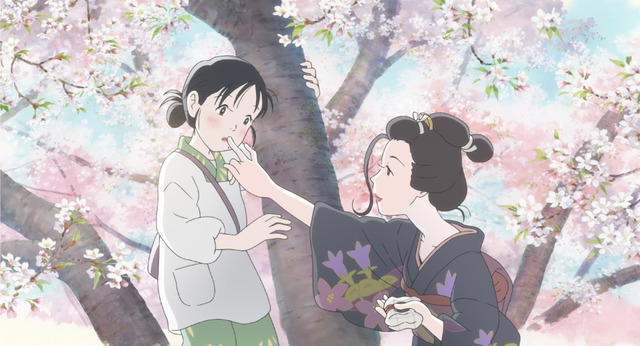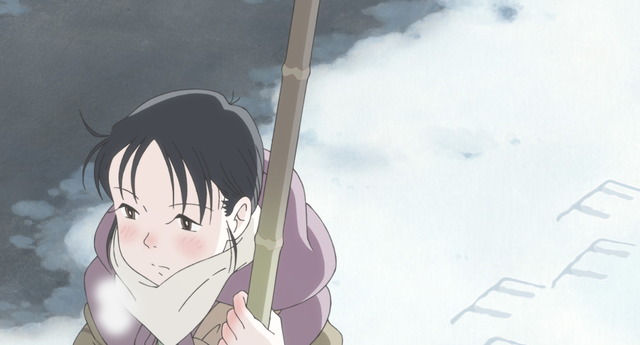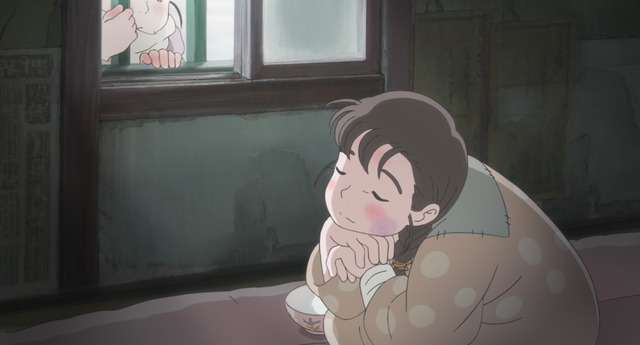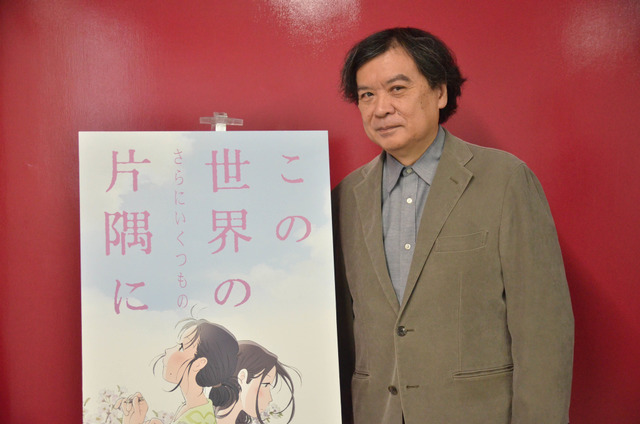The movie “In This Corner (and Other Corners) of the World” by Director Katabuchi Sunao based on the original work by Kouno Fumiyo premiered on Dec. 20.
Following its release in 2016, the box office phenomenon movie “In This Corner of the World” soon became a hot topic all over the internet. Since its release, the movie enjoyed an astounding 3-year successful long-run.
The extended 2019 version of the film has a total of 250 new cutscenes compared to its original 2016 version.
It's not simply the same movie with newly added scenes, it's reborn into a completely new movie exploring Suzu's life in-depth.
Director Katabuchi Sunao made himself available for an interview during the hectic final moments of production before the premiere.
Directo Katabuchi Sunao
*The following interview contains excerpts regarding the extra scenes in the extended version. The writers and editors of this interview were exposed to an earlier version of the movie which was shown during the Tokyo International Film Festival, with a runtime of 2 hours and 40 minutes. More scenes were still being added for the final released version in the moment the director was interviewed.
■New Findings from Research
–We heard that even after the release of the original film in 2016 you still kept on researching. Does this mean that you were planning to make an extended version from the start?
Katabuchi: I'm constantly researching, not only in this particular case. Once I turn my antenna on, I just keep going; gathering as much information as I can regarding the topic on hand and other things I'm curious about.
For instance, even though the movie was made with basis on the information I had previously gathered while researching Hiroshima's Nakajima Honchou, more information happened to be made available after the release in 2016. With that in mind, I felt I could add that extra material into the story.
–In what kind of ways was that new material incorporated into the story?
Katabuchi: In the movie, there's this kimono shop based on a real location that is now a rest house located near the Hiroshima Peace Memorial Museum. Meaning this building was only 170 meters from the epicenter of the explosion during the bombing and remained intact afterward. It is still being used today..
I wanted something that could be actually touched in real life to be part of the story. Movies are by nature an intangible medium, solely projected onto a screen. My intuition was to add to that by including this building on the background, that can actually be touched and it is currently operated as a facility, unlike the Atomic Bomb Dome. And it also means that people can go stand where Suzu once stood.
Since the rest house is a 3-store tall building, it had to be on the corner of the screen frame in order to fit it in. Obviously we had to fill up the spaces next to it with neighbor buildings. And right beside it, there is a store called Oritsu-ya. When we were making the original 2016 version of the movie, there were only blurry photos of the building available..
However, after that, one of the grandchildren of the owner of the store gave me one piece of wrapping paper that was actually used back then.
Also, I was able to obtain photos of the store that weren't trimmed and in higher resolution at Peace Memorial Museum. By analyzing the closely wrapping paper and the store logo in the photos, I came to the conclusion that the store was way more modern than it was thought to be originally. In the extended version, changes were made to accommodate discoveries like this.
Almost all of the buildings shown in the movie are real ones. The reason behind it was to make this movie a time-machine.
I wanted the audience to feel like they were actually visiting those places, at that time.
Since a movie piece is something that will be around for ages, I didn't want to leave behind something that was historically wrong or a fabrication even to the smallest details. This is a similar point that the two versions of the movie share, and I tried my best to achieve.
There is however a difference in the central theme, between the new extended version “In This Corner (and Other Corners) of the World”, and the 2016 original version “In This Corner of the World “.
The premise behind the 2016 version, was to convey the sense of traveling through time and meeting Suzu, the embodiment of the essence of the people who lived in that time.
In contrast to that, in the extended 2019 version, Suzu is simply yet another person among the characters living in that time frame, and the story is not centered exclusively around her.
I really wanted to deliberately delineate the lives of these people as much as Suzu; their worries, suffering, and joyfulness.
–Compared to the 2016 version, I felt a much more strong emphasis in Suzu's story this time, though.
Katabuchi: In the 2016 version, Suzu's character was shown through an external lens, so you might have the impression that she is a bit of an airhead and does funny things.. But even someone with her personality has to deal with real problems and struggle throughout life overcoming suffering.
We are all the same as human beings, but our circumstances can have other interpretations when viewed through different perspectives. This time I wanted to display Suzu as an individual character, instead of a higher level symbolic anime character with whom the story's plot is focused on.
■A radical change in tone through the new scenes
–With the added extra scenes, the already existing scenes got a entire new sense of tension in them. I personally felt that when Suzu feels that she doesn't belong to the Hojo family, that sense of not belonging becomes even more evident, emphasizing the importance of having a place where one can be oneself.
Katabuchi: Exactly. And I think that this is the core of the new extended version.
–I also felt that the marriage between Suzu and Shusaku outlined in the movie has an extra layer of complexity when compared to the original manga. In the movie there are even extra lines that aren't present in the manga.
Katabuchi: The reason why Shusaku decided to marry Suzu is unclear, even in the manga. Kobayashi's aunt infers a hint in one of her dialogues regarding his intentions. I personally believe there's always a reason for everything, even for something that was not clearly stated before.
The aunt & uncle couple are the only middlemen besides the couple's families to be present in the marriage ceremony. That's why I decided to have Suzu and Shusaku's marriage to be conveyed through their dialogue.
It's all just conjecture though. There's no way they really know in fact what Shusaku's true feelings are. And if you ask me if they truly understand what's going on in Shusaku's heart, I'd say no.
There's a likelihood that Shusaku's intention might not be what it appears to be initially, but you'll never know. So you shouldn't accept everything they say without questioning first.
–Hearing that makes me feel that this movie is actually a frightful one.
Katabuchi: Maybe. In animes and movies, it's easy to fall into the trap of thinking that the plot on the surface is everything. I think that “In This Corner (and Other Corners) of the World” and “In This Corner of the World” are able to depict the same breadth of complexity of the world we live in.
–One of the highlights of the extra scenes is the one about Shiraki Rin. What kind of role did you intend for her to play in the movie?
Katabuchi: Like Non-Chan (Nounen Rena), who voices Suzu, pointed out, Rin is the only person who ever requested Suzu to make a drawing for her. Even though Suzu has on her own accord made drawings for other people.
Even Shusaku didn't find out that Suzu drew until later on. In other words, Rin's existence itself serves as an affirmation for Suzu's character.
Before marrying, Suzu had her younger sister and same-age friends from school. But after becoming a member of the Hojo family she was suddenly surrounded only by people older than her. In this situation, she finally meets Rin, someone around her own age and someone who acknowledges her craft.
Normally one could think Suzu would get jealous when she starts suspecting that there might be something going on between Rin and Shusaku. However due to the nature of the relationship they have, Suzu is actually worried that Rin will end up distancing herself.
–Ah.. So she would be worried that Rin would become distant from their relationship, instead of worrying that she would steal Shusaku from her?
Katabuchi: Yeah. There's an 'underground floor' inside Suzu's heart. There lies not her careless innocent usual self, but a much more deep persona that thinks that she doesn't necessarily need to make drawings, but does so in order to express herself. By having someone else, Rin, to acknowledge that, she gains a fulfilling sense of relief.
–The newly introduced character Teru is someone who gets cheered up by Suzu's drawings.
Katabuchi: Teru is a character that is struggling and barely keeping it together. While saying things as 'I might as well be dead', she still searches for traces of hope deep within.
Kanazawa Kana who voiced Teru in the movie did a splendid job playing such a complex character. Teru's scene holds a special meaning among the extra scenes.
–With more scenes of Rin and Teru,the womens' presence has gotten stronger in the film by the insertion of the extra scenes. Were you intentional about it?
Katabuchi: It is indeed a story about women, but for the scenes currently being edited I'm also thinking about adding a bit of background of what men were doing at that time as well.
In the last day of the war, men are burning blueprint papers and women are cooking the rice. Although the men were supposed to be involved in constructive projects, when the war ended all their labor turned to ashes. In the extra scenes, it is shown how those blueprints were actually used.
–I believe this is also something that is not present in the manga.
Katabuchi: It's not. Since the manga is based on real facts and locations, it's quite easy to fill out the gaps of what people at the time were making by doing thorough research. For example, Shusaku's father's history is written down, so we can logically find more about which factory he used to work at and what products were being manufactured there by doing some investigatigation.
Also in the 2016 version, there's a line about the 2000 horsepower engine that isn't in the original manga. I'm also planning to include a few more details about how his father's workplace struggled to create that engine in the new version.
–By adding those extra elements, it gives the movie a different feel to it?
Katabuchi: Yes. This is the counterpart to the daily lives lead by the women in the movie. I was planning to add that since the beginning.
Originally in the manga, there's a part where the relationship between Mizuhara Tetsu and Suzu when they were children is explored in depth. I'm planning to add a scene where Testu pulls Suzu's hair.
I will add a scene about the Makurazaki Typhoon that happened in Sep. 1945 too. There's been a lot of casualties this year and the last year caused by typhoons and floods.
The Makurazaki typhoon in the original manga is depicted as a commemorative happening, a sign from liberation from the war. However in reality it was much cruder than that, as more people died from the typhoon than battling during the war in Kure city in real life.
Suzu's life continues even after the war. People die, and not only in war. I wanted to provide value for those who carry on; that's why I decide to insert the typhoon scene in the movie.
■The power of depicting people's lives through anime
–You've depicting people's lives through animation in your career. What made you choose that medium instead of live action? Can you talk more about it and it's merits?
Katabuchi: What I've done can also be achieved through live action. However there certain aspects of storytelling that can be made much more prominent in animation.
By depicting a character's life, you're outlining his/her very existence. You can give even a character with a four-heads-tall proportion a tone of seriousness by doing so.
–It's incredible realizing how dramatic the life of a person can be when conveyed through animation.
Katabuchi: Yeah, it's true. Our surroundings are full of events and things that pass by unnoticed normally, but when we see that on the screen, we then suddenly start turning our attention back to them. In animated movies, those things become even more noticeable.
–In this movie even the rice cooking scenes are emotional. I supposed taking a rice cooking scene to this level in live action would be very difficult. By watching it I started thinking to myself, what a magnifcient thing the act of cooking rice actually is.
Katabuchi: Yeah. This in my opinion is the power of animation.












